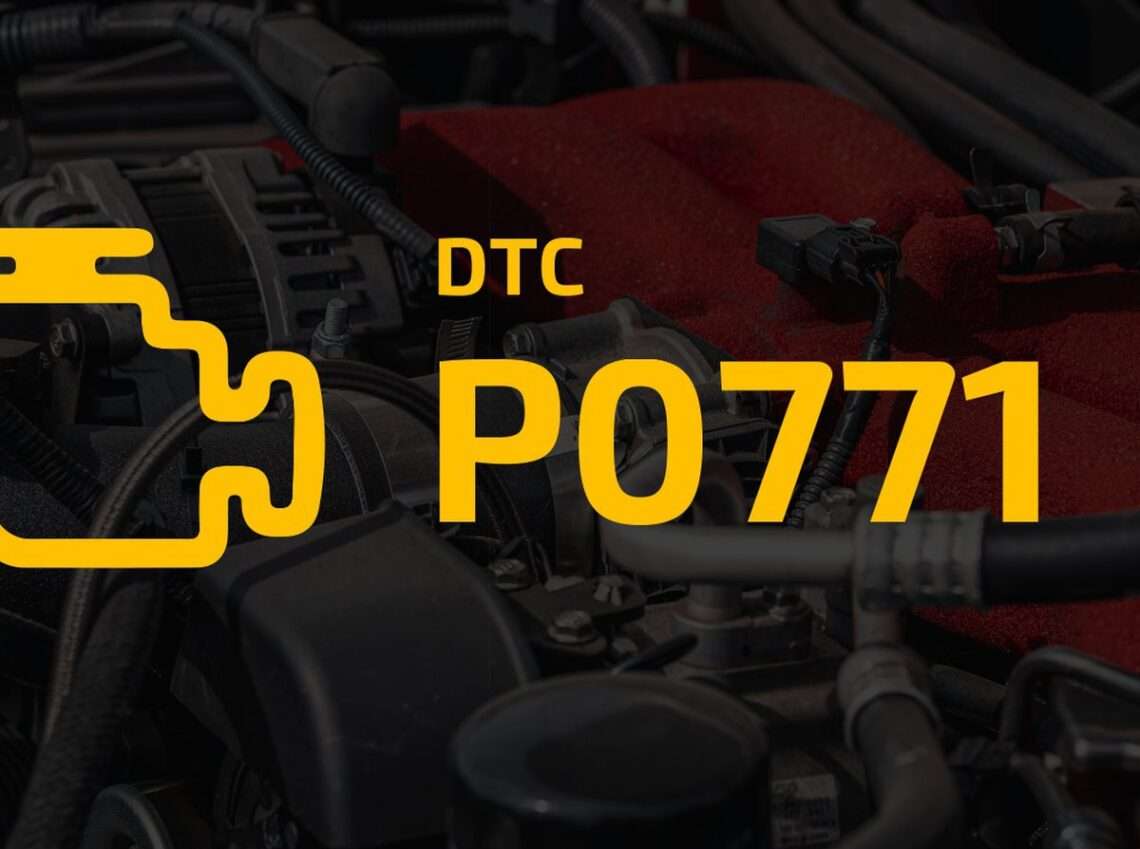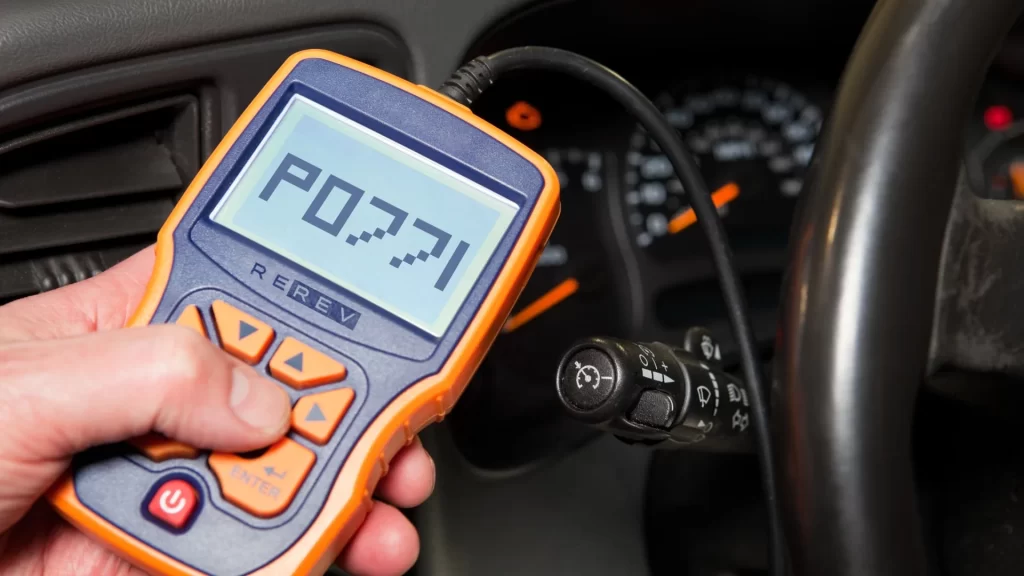
P0771 Shift solenoid valve “E” performance or stuck off
Content
P0771 – OBD-II Trouble Code Technical Description
Trouble code P0771 indicates that the vehicle's computer has detected a problem with the shift solenoid valve "E".
What does the fault code mean P0771?
Trouble code P0771 indicates a problem with the “E” solenoid valve in the vehicle's shift system. Automatic transmission vehicles use solenoid valves to automatically adjust the flow of transmission fluid to ensure proper vehicle operation and smooth gear shifts. The cause of this error may be an electrical malfunction of the solenoid valve or its clogging, which leads to it jamming.

Possible reasons
Some possible reasons for the P0771 trouble code:
- Solenoid valve “E” malfunction: The electric valve may be damaged or not function properly due to wear, corrosion, or other damage.
- Clogged or blocked valve: Accumulation of dirt, metal shards or other contaminants can cause the valve to become blocked and not function properly.
- Electrical Problems: Incorrect electrical connections, opens, or shorts in the valve control circuit can cause P0771.
- Transmission Controller Problems: Problems with the automatic transmission controller can also cause P0771.
- Low or Defective Transmission Fluid: Low or contaminated transmission fluid can also cause problems with the solenoid valve and cause this trouble code to appear.
What are the symptoms of a fault code? P0771?
Some possible symptoms when trouble code P0771 occurs:
- Shifting Problems: The vehicle may have difficulty shifting gears or may not shift into certain gears at all.
- Unusual changes in transmission performance: There may be sudden jerks or jerks when shifting gears, or sudden changes in engine speed or vehicle speed.
- Check Engine Light Illumination: When P0771 occurs, the Check Engine Light will illuminate on the instrument panel.
- Increased fuel consumption: Improper operation of the transmission can lead to increased fuel consumption due to inefficient use of gears and increased engine load.
- Increased noise or vibration: Improper gear shifting can cause additional noise or vibration from the transmission or engine.
How to diagnose a fault code P0771?
To diagnose DTC P0771, you can follow these steps:
- Scan error code: Use a vehicle OBD-II scanner to read trouble code P0771 and any other trouble codes that may be related to the transmission.
- Checking the level and condition of the transmission fluid: Check the level and condition of the transmission fluid. Low fluid levels or contamination can cause problems with the shift valve.
- Visual inspection of solenoid valve E: Check the electrical connections and cables associated with the shift solenoid valve “E”. Make sure all connections are secure and there are no signs of damage or oxidation.
- Resistance test: Use a multimeter to check the resistance of solenoid valve “E”. The resistance must be within the values specified in the technical manual.
- Checking transmission pressure: Measure the pressure in the transmission system using a special pressure gauge. Low pressure may indicate problems with the shift valve or other transmission components.
- Checking the gearbox software (firmware): In some cases, the problem may be related to the software (firmware) of the transmission control module. Check for firmware updates and update if necessary.
- Additional tests and tests: Depending on the specific conditions and nature of the problem, additional tests such as transmission mechanical components and other tests may be required.
If necessary, it is recommended to contact a professional mechanic or car service for more detailed diagnostics and repairs.
Diagnostic errors
When diagnosing DTC P0771, the following errors may occur:
- Incorrect interpretation of code: Some mechanics or car enthusiasts may misinterpret the P0771 code and think it is a problem with the “E” solenoid valve when the root of the problem may be another transmission component.
- Skipping Basic Component Check: In some cases, mechanics may skip checking basic components such as transmission fluid level and condition, electrical connections, or solenoid valve resistance, which can lead to an incorrect diagnosis.
- Incorrect component replacement: Sometimes, when receiving a P0771 code, mechanics may immediately assume that the “E” solenoid valve needs to be replaced without conducting sufficient diagnostics, which can result in unnecessary repair costs.
- Ignoring other potential problems: Trouble code P0771 may be related to other problems in the transmission, such as pressure problems, mechanical damage, or problems with the control module software. Ignoring these potential problems may lead to incomplete or incorrect diagnosis.
- Incorrect interpretation of diagnostic data: In some cases, errors may occur due to incorrect interpretation of diagnostic data obtained using specialized equipment or an OBD-II scanner.
To prevent these errors, it is important to carry out systematic and comprehensive diagnostics, including checking all associated components and carefully examining diagnostic data. If you are unsure of your diagnostic skills, it is recommended that you contact a qualified mechanic or auto repair shop.
How serious is the fault code? P0771?
Trouble code P0771 indicates a problem with the “E” solenoid valve in the vehicle's transmission. Depending on the specific nature of the problem and its impact on transmission performance, the severity of this code may vary.
In some cases, the problem may be relatively minor and not greatly affect the performance of the vehicle. For example, it could be temporary electrical noise or a small valve abnormality that does not cause serious problems with the gears.
However, in other cases, if the solenoid valve problem is severe and causing the transmission to malfunction, it may result in the following:
- Loss of control over gears: The vehicle may lose control of the gears, which may result in jerking, unexpected gear changes, or difficulty changing gears.
- Deterioration in fuel economy: Improper transmission operation may result in increased fuel consumption due to improper gear shifting.
- Transmission damage: Extended use with a malfunctioning solenoid valve may cause wear or damage to other transmission components.
Therefore, it is important to take the P0771 code seriously and diagnose it to resolve the problem as soon as possible and prevent possible negative consequences.
What repair will help eliminate the code? P0771?
The repair needed to resolve the P0771 code will depend on the specific cause of the problem, several possible actions are:
- Replacing solenoid valve “E”: If the problem is caused by a fault in the valve itself, it should be replaced. This may require removing and disassembling the transmission to access the valve.
- Repair or replacement of wiring and connectors: Sometimes the error may be caused by an electrical fault such as a broken wire or poor contact in the connector. In this case, it is necessary to diagnose the electrical circuit and repair or replace faulty components.
- Cleaning or replacing the valve filter: If the problem is caused by a clogged valve, you can try to clean it or replace the filter, if there is one.
- Transmission controller software update: In some cases, the problem can be solved by updating the software (firmware) of the transmission controller. This may correct transmission control problems.
- Additional diagnostics and repairs: If the causes of the error are complex or not obvious, more in-depth diagnosis and repair may be required, including checking other components of the transmission.
It is important to carry out diagnostics to accurately determine the cause of the P0771 error, and only then proceed with repairs. If you do not have experience in carrying out such work, it is recommended that you contact a qualified auto mechanic or auto repair shop.
P0771 – Brand-specific information
Trouble code P0771 can occur in various makes and models of vehicles with automatic transmission, here are some examples of P0771 trouble codes for various manufacturers:
- Ford: Trouble code P0771 may indicate “Shift Solenoid E Performance/Stuck Off.”
- Toyota: For Toyota, this code may indicate “Shift Solenoid E Performance/Stuck Off.”
- Honda: For Honda, this code may mean “Torque Converter Throttle Control Solenoid Malfunction.”
- Nissan: On Nissan vehicles, this code may indicate “Torque Converter Throttle Control Solenoid Malfunction.”
These are just a few examples, and the meaning of the P0771 code may vary depending on the specific model and year of the vehicle. For accurate information, please refer to the repair or diagnostic manual for your specific vehicle make and model.